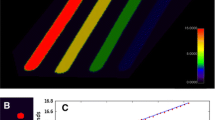Abstract
To examine in vitro whether an assessment of flow in normal and obstructed vessels is essentially possible using modern multislice CT-scanners. An experimental model allowed known stenoses to be perfused at defined flow rates. Aorta and coronary arteries were simulated by silicone tubes. A pulsatile pump was used to perfuse water through the system with intermittent injection of a bolus of radio-opaque contrast agent. CT-measurements were carried out with slice orientation perpendicular to the tubes. 50–90% concentric stenoses were examined 5 times at 4 different stenosis slice distances. A mathematical algorithm calculated the temporal density changes within a ROI in the tube cross-sections. Quantitative assessment of the data simultaneously acquired with the 16-slice system for the “coronary” and “aortal” time-density curves showed that the model allowed for exclusion of a ≥ 80% stenosis grade with a 99% probability when the slopes of the density increase quotient was > 0.79; a stenosis grade of ≥ 90% could be excluded when the slopes of the density increase quotient was > 0.52. A Quotient > 0.94 for “peak density” was associated with a 99% probability of a stenosis grade ≥ 70%. The 64-slice system allowed stenosis grades of ≥ 80% to be discriminated from lower grades. The general feasibility of the in vitro approach was verified in an in vivo model. The spatial, contrast and temporal resolution of CT scanners with at least 16 detector rows enables qualitative and semiquantitative assessment of stenotic changes in flow.





Similar content being viewed by others
References
Bluemke DA, Achenbach S, Budoff M et al (2008) Noninvasive coronary artery imaging: magnetic resonance angiography and multidetector computed tomography angiography: a scientific statement from the american heart association committee on cardiovascular imaging and intervention of the council on cardiovascular radiology and intervention, and the councils on clinical cardiology and cardiovascular disease in the young. Circulation 118(5):586–606. Epub 2008 Jun 27
Budoff MJ, Dowe D, Jollis JG et al (2008) Diagnostic performance of 64-multidetector row coronary computed tomographic angiography for evaluation of coronary artery stenosis in individuals without known coronary artery disease: results from the prospective multicenter ACCURACY (Assessment by Coronary Computed Tomographic Angiography of Individuals Undergoing Invasive Coronary Angiography) trial. J Am Coll Cardiol 52(21):1724–1732
Garcia MJ, Lessick J, Hoffmann KH for the CATSCAN Study Investigators (2006) Accuracy of 16-row multidetecor computed tomography for the assessment of coronary artery stenosis. JAMA 296:403–411
Groothuis JG, Beek AM, Brinckman SL et al (2010) Low to intermediate probability of coronary artery disease: comparison of coronary CT angiography with first-pass MR myocardial perfusion imaging. Radiology 254:384–392
Mowatt G, Cook JA, Hillis GS, Walker S, Fraser C et al (2008) 64-Slice computed tomography angiography in the diagnosis and assessment of coronary artery disease: systematic review and meta-analysis. Heart 94(11):1386–1393. (Epub) 2008 Jul 31. Review
Hoffmann U, Moselewski F, Cury RC et al (2004) Predictive value of 16-slice multidetector spiral computed tomography to detect significant obstructed coronary artery disease. Circulation 110:2638–2643
Meijboom WB, Meijs MF, Schuijf JD et al (2008) Diagnostic accuracy of 64-slice computed tomography coronary angiography: a prospective, multicenter, multivendor study. J Am Coll Cardiol 52(25):2135–2144
Miller JM, Rochitte CE, Dewey M et al (2008) Diagnostic performance of coronary angiography by 64-row CT. N Engl J Med 359(22):2324–2336
Gould KL (2009) Does coronary flow trump coronary anatomy? JACC Cardiovasc Imaging 2(8):1009–1023
Axel L (1983) Tissue mean tranit time from dynamic computed tomography by a simple deconvolution technique. Invest Radiol 18:94–99
Bell MR, Lerman LO, Rumberger JA (1999) Validation of minimally invasive measurement of myocardial perfusion using electron beam computed tomography and application in human volunteers. Heart 81:628–635
Rumberger JA, Feiring AJ, Lipton MJ, Higgins CB, Ell SR, Marcus ML (1987) Use of ultrafast computed tomography to quantitate regional myocardial perfusion: a premininary report. J Am Coll Cardiol 9:59–69
Wang T, Wu X, Chung N, Ritman EL (1989) Myocardial blood flow estimated by synchronous multislice, high-speed computed tomography. IEEE Trans Med Imaging 8(1):70–76
Wolfkiel CJ, Ferguson JL, Chomka EV, Law WR, Labin IN, Tenzer ML, Booker M, Brundage BH (1987) Measurement of myocardial blood flow by ultrafast computed tomography. Circulation 76:1262–1273
Nagao M, Kido T, Watanabe K, Saeki H, Okayama H, Kurata A, Hosokawa K, Higashino H, Mochizuki T (2010) Functional assessment of coronary artery flow using adenosine stress dual-energy CT: a preliminary study. Int J Cardiovasc Imaging 26(6):567–569
Acknowledgments
The authors wish to thank Svetlana Paperno, MD, Thomas Barzt, MD, (Group Practice and Radiology Group “Strahleninstitut in the CDT GmbH”, Cologne), and Stephan Grimme, MD, for their help with the experiments.
Author information
Authors and Affiliations
Corresponding author
Rights and permissions
About this article
Cite this article
Lackner, K., Bovenschulte, H., Stützer, H. et al. In vitro measurements of flow using multislice computed tomography (MSCT). Int J Cardiovasc Imaging 27, 795–804 (2011). https://doi.org/10.1007/s10554-010-9728-7
Received:
Accepted:
Published:
Issue Date:
DOI: https://doi.org/10.1007/s10554-010-9728-7




